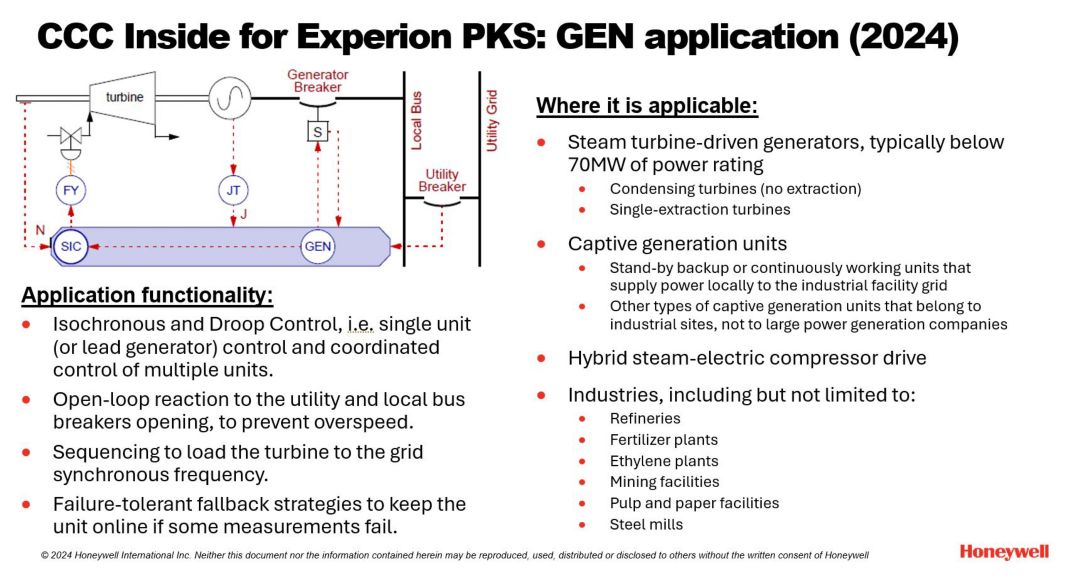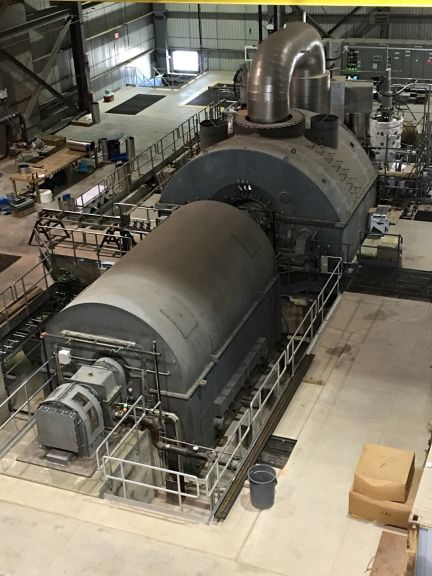Generator
Generator Control
CCC’s GEN application provides a way to coordinate steam turbine speed control with the power grid behavior.
Please sign in to access more documents
Once signed in, you may be able to access additional documents for your account.
A Generator control application (GEN) works with companion Speed (SIC) or Fuel (FC) control applications to provide speed and megawatt droop (load) control, in addition to sequencing and protective responses, to control the speed of the turbine-generator set while on and off the local and utility grid. Synchronous, alternating-current generators are usually connected to a local electrical bus via a generator breaker. An electrical current will be delivered into that circuit only when that breaker is closed, in which case the generator is said to be on-line. If only one generator is connected to a bus, a fixed frequency can be maintained only by manipulating the steam or fuel flow to maintain a constant speed. When several generators are interconnected on the local or on the utility grid, electromagnetic forces equalize their frequencies. The rotational speed of each is always a fixed multiple of the bus frequency.
What Is It and how does it work?
A turbine controller (SIC) is configured to work with a companion generator (GEN) controller.
When the generator breaker is open, the turbine controller will regulate the turbine speed.
- If the generator breaker is closed but the utility breaker is open, Isochronous Control or Droop Control are applied:
- Isochronous control selects the speed control/limiting loop, with the local set point corresponding to the unit’s nominal synchronous speed and frequency.
- Droop control selects the Generator loop, which regulates speed using a separate set of PID coefficients and a local set point supplied by the generator controller.
- If both the generator and utility breakers are closed, Droop Control is applied.
In the event of a sudden, large load change, droop control will stabilize the grid frequency at an offset from its desired value. In addition, a generator control application can be configured to automatically reduce its power set point if that offset exceeds specified limits.
What Problems Does It Solve?
Generator control application provides functionality required to control a single or multiple generator sets connected to local power bus and to utility power grid. When connected to the grid, the speed controller cannot directly change the speed of the turbine – it is synchronous with the grid frequency. On the other hand, grid frequency depends on the speed of the turbines supplying power. To provide stable and reliable quality of the grid frequency, the desired frequency is maintained by controlling the speed of one unit. All others are regulated using droop control to keep the steam or fuel flows to their turbines proportional to the difference (droop) between their speeds and speed set points (which are calculated as a function of their power set points):
- A rise in the frequency and generator speeds reduces each controller’s droop, causing it to reduce its turbine’s power output.
- A drop in the frequency and generator speeds increases each controller’s droop, causing it to raise its turbine’s power output.
One of the most important algorithms deals with a situation when the breaker opens – either the breaker with the main power grid, or the breaker with the local utility grid, or both simultaneously. If the utility breaker opens while the local bus is importing or exporting power to the grid, a companion logic controller initiates step changes in their outputs and set points and switch one of the turbines to isochronous control to minimize the impact on the local bus.
Who is it for?
This application is important for the industrial users that need to control generator sets for exporting power to the local power bus and/or to the utility power grid. It is designed for those users who need coordinated control of the steam turbine and generator operation, to maintain grid frequency and deal with the situations when the bus and grid breaker(s) open.
One of the examples of such a unit can be a captive generation train that utilizes exhaust gases or steam from other chemical processes to generate power. Those units often serve as stand-by power generation assets. They need to quickly start up and supply power to the local plant grid in case the large public grid disconnects for any reason. CCC GEN application in combination with turbine speed governor is an ideal system for such units.
Alternatively, the captive generation unit can be in continuous operation and export power to the local plant grid that is, in turn, connected with the larger public grid. In such a situation, the GEN application will coordinate control with the grid frequency and ensure that it responds to changes in frequency by supplying more or less power to stabilize the frequency with all other suppliers.
Another common example can be a turbine-compressor train that also has a large electric motor providing power. In that situation the steam turbine governor can’t control turbine speed – it is synchronized with the speed of the motor and eventually with the grid frequency. But in case of sudden opening of the grid breaker stem turbine has to be able to take over the load in a matter of milliseconds. That is where GEN application comes into play and provides smooth, but quick transfer between the operating modes.
Brochure
Please sign in to view part numbers available for purchase based on your account Sign In




